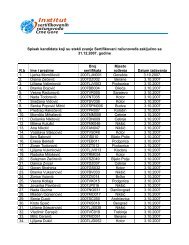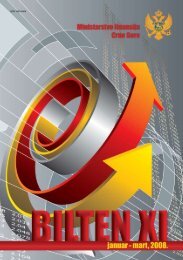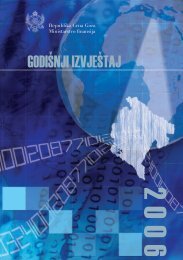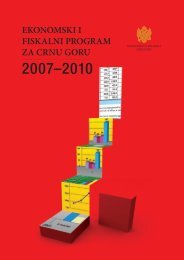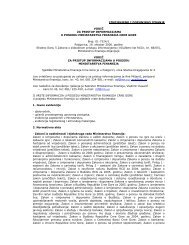Republic of Montenegro: Public Expenditure and ... - Vlada Crne Gore
Republic of Montenegro: Public Expenditure and ... - Vlada Crne Gore
Republic of Montenegro: Public Expenditure and ... - Vlada Crne Gore
You also want an ePaper? Increase the reach of your titles
YUMPU automatically turns print PDFs into web optimized ePapers that Google loves.
32<br />
Chapter 2: Composition <strong>of</strong> <strong>Public</strong> <strong>Expenditure</strong> <strong>and</strong><br />
Key Sources <strong>of</strong> Fiscal Pressure<br />
generally do better in larger classes. 40 The recent assessment shows that performances in math<br />
<strong>and</strong> mother tongue increase as class size increases. For example, the correlation between math<br />
performance <strong>and</strong> class size increases from 0.40 to 0.58 as the class size grows from under 5<br />
students to above 25 students. This finding, although contrary to the usual expectation <strong>of</strong> policy<br />
makers, is consistent with a large body <strong>of</strong> international research which shows that, within a wide<br />
range <strong>of</strong> class size, achievement does not significantly differ. Second, students in satellite<br />
schools generally do considerably worse than students in associated mother schools. Taken<br />
together, these two findings imply that average performance would not decline (<strong>and</strong> may even<br />
rise) if small classes <strong>and</strong> satellite schools were closed <strong>and</strong> pupils were taught in larger classes<br />
<strong>and</strong> schools. This outcome would be reinforced if some <strong>of</strong> the savings from the closed schools<br />
were invested in improving the quality <strong>of</strong> the remaining schools in the network.<br />
Reforming Secondary Vocational Education<br />
2.49 Reforming vocational education is another potential source <strong>of</strong> savings. Vocational<br />
education programs in <strong>Montenegro</strong> have a poor record <strong>of</strong> providing the skills <strong>and</strong> knowledge<br />
needed for labor market entry. They also provide less opportunity for entry to further education.<br />
A study <strong>of</strong> secondary education students who graduated in 2004 looked at what they were doing<br />
one year later 41 . The study found that young people’s prospects depend very greatly on the type<br />
<strong>of</strong> secondary program they attended, with those attending four year programs overwhelmingly<br />
better <strong>of</strong>f – either because they were able to attend further schooling (usually a public university)<br />
or find employment (Table 2.12). Currently, approximately two-thirds <strong>of</strong> students are enrolled in<br />
various vocational programs.<br />
Table 2.12. Outcomes for Students Leaving Secondary Education in 2004 by Type <strong>and</strong> by<br />
Length <strong>of</strong> Secondary Program<br />
Status Type <strong>of</strong> secondary program Length <strong>of</strong><br />
secondary<br />
program<br />
Gymnasium Secondary Secondary Crafts Field <strong>of</strong> 3 years 4 years<br />
vocational technical program service<br />
Continued<br />
91 57 53 6 35 7 73<br />
schooling<br />
Unemployed 7 24 30 80 50 77 18<br />
Employed 2 18 12 14 14 15 9<br />
Other 1 3 1<br />
Total 100 100 100 100 100 100 100<br />
Source: Strategic Marketing Research, Survey <strong>of</strong> Secondary School Completers, manuscript, May-July 2005.<br />
2.50 While the three-year programs are specifically intended for those who will enter the<br />
labor market immediately after graduation, they fail in this mission. This represents,<br />
therefore, a waste <strong>of</strong> public resources as these programs are predominately funded by the budget.<br />
Those who entered the labor market directly after graduating from secondary school, rather than<br />
40 It has not been possible to conduct a more detailed analysis to exclude the possibility that this outcome is the<br />
result <strong>of</strong> other factors than simply class size. For example, it may be that larger classes are in urban areas <strong>and</strong> this is<br />
where the better teachers are.<br />
41 Strategic Marketing Research, ‘Survey <strong>of</strong> Secondary School Completers’, May-July 2005, manuscript.




